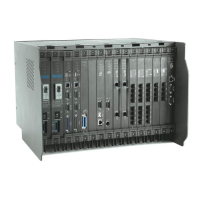Matrix ETERNITY Quick Start 71
• Select ‘Source Port IP Address’.
• If your VoIP Card is located behind a NAT Router, and you have set
“Router’s Public IP Address” as the NAT Traversal mechanism in the ‘VoIP
Port Parameters’, select the option "Use Router’s Public IP Address”.
• If your VoIP Card is located behind a NAT Router, and you have set ‘Use IP
Address fetched using STUN as the NAT Traversal mechanism in the ‘VoIP
Port Parameters’, select the option “Use IP Address fetched using STUN.
• If your VoIP Card is not located behind a NAT Router, select the option ‘Use
VoIP Ethernet Port IP Address’ as the ‘Source Port IP Address’.
• Go to 'SIP Extension Settings' under VoIP Configuration.
• Select the software port number of the VoIP Ethernet Port to which you want
to assign the SIP Extension. For example, you want to assign SIP
Extensions 1 to 15 to VoIP Ethernet Port number 1, select 01 as port number
from the combo box for these extension numbers.
• Keep the flag ‘Use SIP Extension’ enabled.
• Assign a Name to the SIP extension, a unique SIP ID (number string up to 6
digits) for each SIP extension.
• Assign an Authentication ID, i.e. the number that the VoIP Card's Registrar
Server will use for user authentication of the SIP messages received from
the SIP Extension. The number may be a string of maximum 6 digits from 0
to 9, and the characters * and #. Also assign an Authentication Password of
a maximum of 24 digits. Default password is 1234.
When you assign ‘Authentication ID’ make sure any of the 'Authentication' of
SIP Message Options, viz. REGISTER or INVITE or SUBSCRIBE or
PUBLISH, is enabled.
• Select the number of Call Appearances (i.e. the maximum number of calls)
to be allowed to the SIP Extension user, from 1 to 10. By default, 1 is
selected.
• Enable Authentication of any or all of the SIP Message Options: REGISTER
Request, INVITE Request, SUBSCRIBE Request, Voice mail (VM),
Subscription, Busy Lamp Field (BLF), PUBLISH. By default, the SIP
Message Options REGISTER, INVITE, SUBSCRIBE are enabled.

